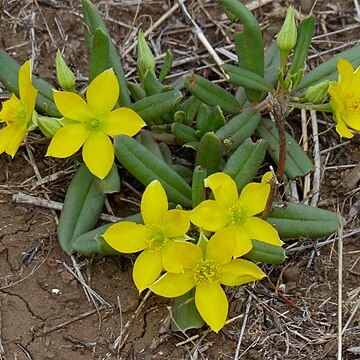Dwarf shrub, 0.03-0.60 m high; root fleshy, tuberous. Leaves succulent, linear to oblong, mostly 20-40 x 3-6 mm, apex mucronate, margins revolute, petiolate; stipules linear, caducous. Inflorescences axillary, cymose 1(2)-flowered; peduncle 5-15 mm long; pedicels mostly 15 mm long. Flowers bisexual, yellow. Sepals 2, lanceolate. Petals 5, obovate, ephemeral. Stamens 25-30(-50). Ovary superior, 1-locular with 3 carpels; conical ovules 25-40. Flowering time Nov.-Feb. Fruit a shiny capsule, ochre, chartaceous, 1-locular, many-seeded, ovoid. Seeds spherical to comma-shaped, ± 1 mm long, dark brown or black, ridged, perpendicular grooves between ridges, hilum distinct, aril small, basal.
A herb. It keeps growing from year to year. It grows about 45 cm tall. It has a deeply buried tuber with annual stems. The leaves are 6 cm long and somewhat fleshy. The flowers are in groups of 1-3 in the axils of leaves. The petals are rich yellow. They are 2 cm long. The seeds are shiny and black. They are in a round capsule.
Dwarf shrub, up to 0.4 m high, Stems semi-erect or decumbent. Leaves linear to oblong, margins irregularly recurved. Flowers: inflorescence 1-flowered; corolla yellow; Sep.-Feb. Seeds with concentric ridges perpendicular, elongate papillae between ridges.
Leaf-lamina somewhat fleshy, 1·5–6 × 0·2–1·5 cm., very variable in shape, typically lanceolate to elliptic-lanceolate or ovate, rarely almost linear, apex subacute, mucronate, cuneate at the base, margin sometimes revolute, petiole up to 4 mm. long.
Erect or decumbent herb with branches up to 400 mm long. Leaves linear to oblong. Inflorescence 1-flowered. Pedicel not thread-like. Seeds with concentric ridges perpendicular, elongate papillae between ridges. Flowers yellow.
Inflorescences axillary, 1-or rarely 2–3-flowered; peduncle c. 2 cm. long, thickened towards the apex, with a pair of subulate bracteoles c. 1·5 mm. long in the upper half.
Seeds c. 20, shining black with a white hilum, 1·5–2 mm. in diam., reniform-globose, with well defined, elevated, concentric ridges.
Perennial glabrous herb c. 40 cm. tall from a thickened turnip-like root c. 12 cm. long; stems suberect or erect.
Petals yellow or golden, about twice the length of the sepals, ovate, rounded at the apex.
Ovary subglobose; style 2–5 mm. long; stigmas 3, 1–2 mm. long, spreading.
Stamens numerous; filaments filamentous, c. 4 mm. long.
Sepals 0·5–1·0 cm. long, ovate, acuminate at the apex.
Capsule subglobose.

